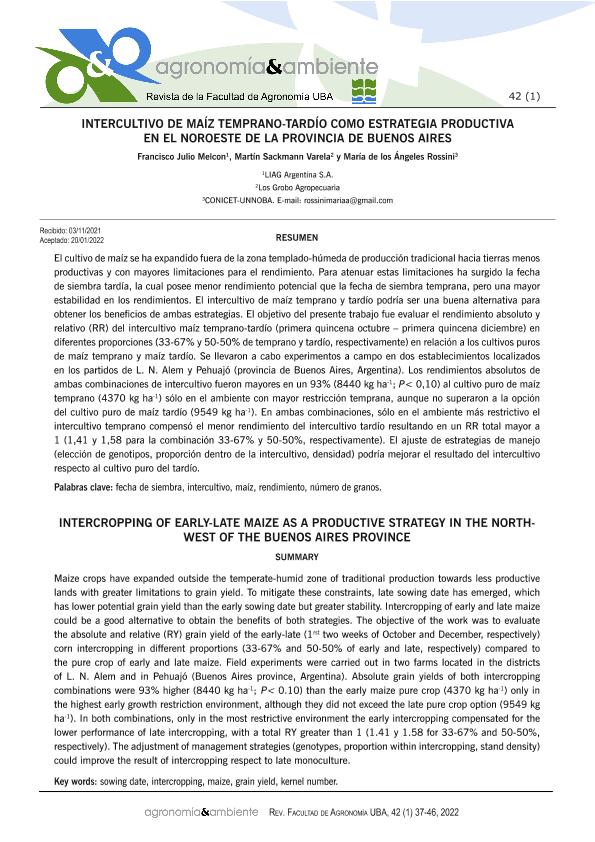Artículo
El cultivo de maíz se ha expandido fuera de la zona templado-húmeda de producción tradicional hacia tierras menos productivas y con mayores limitaciones para el rendimiento. Para atenuar estas limitaciones ha surgido la fecha de siembra tardía, la cual posee menor rendimiento potencial que la fecha de siembra temprana, pero una mayor estabilidad en los rendimientos. El intercultivo de maíz temprano y tardío podría ser una buena alternativa para obtener los beneficios de ambas estrategias. El objetivo del presente trabajo fue evaluar el rendimiento absoluto y relativo (RR) del intercultivo maíz temprano-tardío (primera quincena octubre – primera quincena diciembre) en diferentes proporciones (33-67% y 50-50% de temprano y tardío, respectivamente) en relación a los cultivos puros de maíz temprano y maíz tardío. Se llevaron a cabo experimentos a campo en dos establecimientos localizados en los partidos de L. N. Alem y Pehuajó (provincia de Buenos Aires, Argentina). Los rendimientos absolutos de ambas combinaciones de intercultivo fueron mayores en un 93% (8440 kg ha-1; P< 0,10) al cultivo puro de maíz temprano (4370 kg ha-1) sólo en el ambiente con mayor restricción temprana, aunque no superaron a la opción del cultivo puro de maíz tardío (9549 kg ha-1). En ambas combinaciones, sólo en el ambiente más restrictivo el intercultivo temprano compensó el menor rendimiento del intercultivo tardío resultando en un RR total mayor a 1 (1,41 y 1,58 para la combinación 33-67% y 50-50%, respectivamente). El ajuste de estrategias de manejo (elección de genotipos, proporción dentro de la intercultivo, densidad) podría mejorar el resultado del intercultivo respecto al cultivo puro del tardío. Maize crops have expanded outside the temperate-humid zone of traditional production towards less productive lands with greater limitations to grain yield. To mitigate these constraints, late sowing date has emerged, which has lower potential grain yield than the early sowing date but greater stability. Intercropping of early and late maize could be a good alternative to obtain the benefits of both strategies. The objective of the work was to evaluate the absolute and relative (RY) grain yield of the early-late (1rst two weeks of October and December, respectively) corn intercropping in different proportions (33-67% and 50-50% of early and late, respectively) compared to the pure crop of early and late maize. Field experiments were carried out in two farms located in the districts of L. N. Alem and in Pehuajó (Buenos Aires province, Argentina). Absolute grain yields of both intercropping combinations were 93% higher (8440 kg ha-1; P< 0.10) than the early maize pure crop (4370 kg ha-1) only in the highest early growth restriction environment, although they did not exceed the late pure crop option (9549 kg ha-1). In both combinations, only in the most restrictive environment the early intercropping compensated for the lower performance of late intercropping, with a total RY greater than 1 (1.41 y 1.58 for 33-67% and 50-50%, respectively). The adjustment of management strategies (genotypes, proportion within intercropping, stand density) could improve the result of intercropping respect to late monoculture.
Intercultivo de maíz temprano-tardío como estrategia productiva en el noroeste de la provincia de Buenos Aires
Título:
Intercropping of early-late maize as a productive strategy in the northwest of the Buenos Aires province
Fecha de publicación:
01/2022
Editorial:
Universidad de Buenos Aires. Facultad de Agronomía
Revista:
Agronomía & ambiente
ISSN:
2314-2243
e-ISSN:
2344-9039
Idioma:
Español
Tipo de recurso:
Artículo publicado
Clasificación temática:
Resumen
Palabras clave:
Intercultivo
,
Fecha de siembra
,
Maíz
,
Rendimiento
Archivos asociados
Licencia
Identificadores
Colecciones
Articulos(SEDE CENTRAL)
Articulos de SEDE CENTRAL
Articulos de SEDE CENTRAL
Citación
Melcon, Francisco Julio; Sackmann Varela, Martín; Rossini, Maria de Los Angeles; Intercultivo de maíz temprano-tardío como estrategia productiva en el noroeste de la provincia de Buenos Aires; Universidad de Buenos Aires. Facultad de Agronomía; Agronomía & ambiente; 42; 1; 1-2022; 37-46
Compartir




